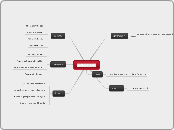Concepts / Categorization
Neurological Evidence
With Alzheimers: Naming Superordinate: Horse--> Animal
Specific deficits for
body parts
Fruit & Vegtables
Living things & Food
Connectionist Explanations
IAC model: Can learn from specific instances and link comon characteristics: Links are knowledge / instances are strength of connections
Psychological essetialism (essential and constraining prop)
Con:
Braisby: Experts say it is a salmon: 25% modify their opinion to conform w. experts
Function and appearane are imp as well
Malt: We are essentialist for natural categories
Boat-Ship: Call it whatever
Trout-Bass: Ask an expert
Braisby: Is a cat still (essentially) a cat a cat even when robot from mars?
Concepts dirven by context and content
50% both true, fals
50 "Yes, cat
Malt: People know, the essece of water is H20
Categorizatio also driven by function, location socio-historical context
Pond is water although judged to contain only 63% H20
Tears are not water although rated to contain 87% H20
Pro
Gelmann and Wellman: a dog still dog if inside is taken (4-5 yrs: no)
Difference to classical view
A placeholder can change
Filling the placeholder is job of science
If we are not shure: we create a placeholder
We have a belief about essential prop
Comon-Sense "Theoroy"
Top down: with more complex situations we have to think
Bottom up: Facilitated by similarity
knowledge involved - not mere lists
Its rather knowledge than theory
Underspciefied: How are complex categories/ theories combined?: pet fish
Good because it hints to problems with "similarity"
Developemental Evi: Kiel: characterisic to defining shift
Murpy: They dont know about biological categories
Racoon disguised as a skunk
Looks and Behaves like Zebra: 4 yrs-zebra 7 yrs-horse
Kroska and Goldstone: 2 emo Szenario categorzed as fear but more similar to joy
Rips Pizza Dissotiation: More similar to quater but more likely (=categorized) a pizza
Problem with similarity: What properties are looked at? (Plumes and Lawnmowers-> knowledge makes the difference)
Rich Internal Structure
Typical members (Prototype views)
Demarcatino Line (Classical View)
Prototype theories (graded, some more typical than others)
Prototype: Other members determined by comp with typical member
Evaluation
Unclear Definition: Are prototypes lists or typical members?
Family resemblence often predicts typicality scores
Explains many categories that lack clear definitions (game, furniture)
Semanitc Transfer?: Complex Concepts Lead to wrong interpretaions in real life: pet-fish = dog trout
Barsalou: goal derived categories have no family resemlance: presents that john likes
Medin & Shoeben: typicality context dependent: kaffeelöffel paradox: large wooden>small wooden
Implies we only use lists of attributes but we also use reason: blue bird=probably "warrum," but fat man is prob not a "klatau"
Hampton: Some astract concepts (belief) has no prototype
Pros
Roesch and Mervis: Robins share more properties with other category member than penguins
Armstrong: defined cat seem to have typiclity: female: mother vs. policewoman
Dual Proces: conept core to judge generel membership, prototype to evlauate instances
Mervis & Roesch: < RT faster and less errors for typical examplars
How we do it?
Calculate family resemblecne: one shared by 16, one by 14=30
high typicality instances match on high weighted values
Statistacl distribution determines weight
More similar features - quciker match
comparing of features with stored rep
What is typicality: Having moreo cue valid features in common with prototype
Weighting=Cue Validity= Some features more important than others e.g. bird=feathers
In some natural objects, attributes cluster together
Categories are not single thing or process
Categorizers differ
Novices: Similarity Driven
Experts: Definition driven
Categorization differ according to action / purpose
Explanation based
Essentialism: Consistent with (current) expertise
Theory: If thing need explanations: This guy is intoxicated: Thats why he jumps the pool
Decision based
Classical: Exact definitions needed: law
Prototype: Fast and Superficial: Fast decisions under uncertainty
Smith & Sloman: Two routes: Similarity or Route based depending on the task
Barsalou: internal structure not fixed but viewpoint and task driven
Types of Categories differ
Fuzzy (red)
Well defined (a triangle)
Classical View (all or none), members are determined by a definition
Cons
Everyday Concepts fuzzy not exact
Borderline Cases
McCloskey & Glucksberg: yes/no
Where does red turn into orange
Possilbly: Lack of knowledge
Typical items: chair= furniture: high over time and people
bookends =furniture?: changes across people and time
Intransitivity: big ben = clock = furniture
Bad RTs: RTs not a good predictor
is a dog an animal < Is a dog a mamal
Varying Knowlege: Experts vs. Normal people
Does not explain Typicality effets
Some things dont have definitions - more holistic
Cats would still be cats even if turs out they are robots from mars
Some Categories have no def. features
Example: Furniture / chair
Wittgenstein: Games are similar
Typicality more important than defining features:
Defined by functional /not defined by pyhsical properties
No neccessary and sufficient properties for all chairs
Pros
Collins & Quillian: Categorization takes longer for 2 levals
A canary is an animal > A canary is a bird
Bachelor: male, unmarried, adult
Hierarchical. Food= Fruit or Vegatables
Transitivity: A=B= C and C= A
Inheritance: Bird inherits all from animal but adds feathers
1. Some propertes in beginning / Most at end
Generality claims
Everybody represents in this way
All concepts are represented this way
Members
are equally good
share a) neccessary and b) sufficient features
All or none are members
Divides the world in distinct classes: taxonomies
Methods
Connectionist models
Neuropsychology
Attribute Lising
Card Sorting
Is
Categorizations not only natural but depend on purpose: "Things to take in case of fire"
concept provides Meaning: Mental Lexicon
A level of recognition
Familiarity: lov level
Semantic Classifacation
Naming
Compression and facilitation
To guide action
Predictions of behaviour
Makes remembering more easiy: All cats have hearts
Mental economy
Mental representations
Forms of reps
abstract, by relations
by Prototype
by Rule / defintion
LTM (Concepts are basic units)
Aquired by autobiographical experience
Procedural Memory
Schemas
Rule based "What to do in a Restaurant"
Semantic Memory
Propositions: "Dogs" bark, Dogs have fur, Dogs are pets









